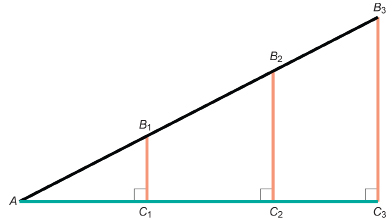Module 7
1. Module 7
1.3. Page 3
Module 7: Trigonometry
Explore
In Module 6 you explored similar right triangles. You discovered that for two similar right triangles, the ratios of their corresponding sides were equal.
side adjacent: the side that forms the right angle with the side opposite
side opposite: the side across from the given angle
hypotenuse: the longest side in a right triangle
Before you move on in this module, you must be able to name the side adjacent and the side opposite to either one of the acute angles of a right triangle. The remaining side is called the hypotenuse of the right triangle.
For instance, look at the diagram of right triangle ABC. For ∠A, the side opposite is side BC. Note that, throughout this module, the side opposite will be coloured orange in many of the examples.
The side adjacent to ∠A is side AC. Note that, throughout this module, the side adjacent will be coloured green in many of the examples.
The hypotenuse of the triangle is side AB. Note that, throughout this module, the hypotenuse will be black boldface in many of the examples.

 Self-Check
Self-Check
Check your understanding of right triangles by going to “Right Triangle Side Names.”
 Try This
Try This
In this Try This activity you will explore the ratio of two sides within a right triangle. You will compare this ratio with ratios involving the same pair of sides from other right triangles. For this comparison you will use the skills for similar right triangles you mastered in Module 6.
You will need your ruler, protractor or square, and your calculator.
Consider the right triangles in the following diagram.

Step 1: Draw a similar diagram to work with.
Step 2: For right triangle AB1C1, measure to the nearest millimetre and record the length of sides B1C1 and AC1.
For right triangle AB2C2, measure to the nearest millimetre and record the length of sides B2C2 and AC2.
For right triangle AB3C3, measure to the nearest millimetre and record the length of sides B3C3 and AC3.
Step 3: Complete the following table, then answer the Try This questions.
|
Right Triangle |
Side Opposite ∠A (nearest mm) |
Side Adjacent to ∠A (nearest mm) |
(2 decimal places) |
|
ΔAB1C1 |
B1C1 = |
AC1 = |
|
|
ΔAB2C2 |
B2C2 = |
AC2 = |
|
|
ΔAB3C3 |
B3C3 = |
AC3 = |
|
TT 3. Explain why ΔAB1C1, ΔAB2C2, and ΔAB3C3 are similar triangles.
TT 4. Because the triangles are similar, the ratio  you calculated should be the same for each triangle. The following statements prove these ratios for ΔAB1C1 and ΔAB3C3 are equal. Supply a reason for each step in the proof.
you calculated should be the same for each triangle. The following statements prove these ratios for ΔAB1C1 and ΔAB3C3 are equal. Supply a reason for each step in the proof.
|
Statement |
Reason |
|
|
|
|
|
|
|
Therefore, |
 Share
Share
Share you answers from the Step 3 table in the Try This activity with as many other students as possible. You may find that the ratios for your triangles were different from the ratios other students obtained. Why might this be? Measure ∠A in your triangles and compare this angle measurement with other students. Can you identify a pattern between the ratio ![]() calculated for the different angle measures?
calculated for the different angle measures?
Summarize the patterns you noticed during this Share, and save a copy of your summary in your course folder.